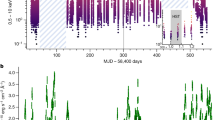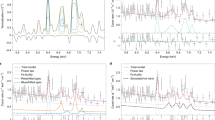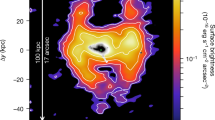Abstract
CATACLYSMIC variable stars are thought to consist of a low-mass star orbiting a more massive white-dwarf primary star. Gas from the secondary star flows onto the white dwarf by way of an accretion disk, and the recurrent outbursts that characterize these objects are attributed to either instabilities in the accretion disk (in the case of dwarf novae) or thermonuclear explosions of material accumulated on the white dwarf (for novae). Observations1,2 of low-luminosity cataclysmic variables have revealed double-peaked emission lines consistent with the accretion-disk picture. But the emission lines associated with high-luminosity cataclysmic variables are single-peaked3–9, which poses a considerable challenge for the disk theory10,11. It has been suggested that winds from the accretion disk, driven by radiation pressure, might be responsible for altering the emission-line characteristics4,10. Here we present a model of the disk wind in which the emission lines arise in a thin layer where the wind emerges from the disk. In our model, the accelerating wind introduces a pronounced anisotropy in the optical depth of the disk, from which single-peaked emission lines naturally arise.
This is a preview of subscription content, access via your institution
Access options
Subscribe to this journal
Receive 51 print issues and online access
$199.00 per year
only $3.90 per issue
Buy this article
- Purchase on Springer Link
- Instant access to full article PDF
Prices may be subject to local taxes which are calculated during checkout
Similar content being viewed by others
References
Young, P., Schneider, D. P. & Shectman, S. A. Astrophys. J. 245, 1035–1042 (1981).
Horne, K. & Marsh, T. R. Mon. Not. R. Astron. Soc. 218, 761–773 (1986).
Young, P., Schneider, D. P. & Shectman, S. A. Astrophys. J. 244, 259–268 (1981).
Honeycutt, R. K., Schlegel, E. M. & Kaitchuck, R. H. Astrophys. J. 302, 388–402 (1986).
Thorstensen, J. R. et al. Astron. J. 102, 272–283 (1991).
Dhillon, V. S., Marsh, T. R. & Jones, D. H. P. Mon. Not. R. Astron. Soc. 252, 342–356 (1991).
Beuermann, K. et al. Astron. Astrophys. 256, 442–446 (1992).
Dhillon, V. S., Jones, D. H. P., Marsh, T. R. & Smith, R. C. Mon. Not. R. Astron. Soc. 258, 225–240 (1992).
Still, M. D., Dhillon, V. S. & Jones, D. H. P. Mon. Not. R. Astron. Soc. 273, 863–876 (1995).
Marsh, T. R. & Horne, K. Astrophys. J. 349, 593–607 (1990).
Dhillon, V. S., Marsh, T. R. & Jones, D. H. P. in Accretion Powered Compact Binaries (ed. Mauche, C.) 127–132 (Cambridge Univ., 1990).
Rutten, R. G. M. et al. Nature 362, 518–520 (1993).
Warner, B. Cataclysmic Variable Stars (Cambridge Univ., 1995).
Williams, R. E. Astron. J. 97, 1752–1758 (1989).
Miyoshi, M. et al. Nature 373, 127–129 (1995).
Eracleous, M. & Halpern, J. P. Astrophys. J. Suppl. Ser. 90, 1–30 (1994).
Kinney, A. L. in The First Stromlo Symposium: The Physics of Active Galactic Nuclei (eds Bicknell, B. V., Doptia, M. A. & Quinn, P. J.) 61–71 (ASP Conf. Ser. 54, San Francisco, 1994).
Murray, N., Chiang, J., Grossman, S. A. & Voit, G. M. Astrophys. J. 451, 498–509 (1995).
Murray, N. & Chiang, J. Astrophys. J. (in the press).
Drew, J. E. Mon. Not. R. Astron. Soc. 224, 595–632 (1987).
Mauche, C. W. et al. Astrophys. J. 424, 347–369 (1994).
Shlosman, I., Vitello, P. & Mauche, C. W. Astrophys. J. 461, 377–385 (1996).
Shlosman, I. & Vitello, P. Astrophys. J. 409, 372–386 (1993).
van Teeseling, A. & Verbunt, F. Astron. Astrophys. 292, 519–533 (1994).
Richman, H. R. Astrophys. J. 462, 404–427 (1996).
Mauche, C. W., Raymond, J. C. & Matei, J. A. Astrophys. J. 446, 842–851 (1995).
Mauche, C. W. in Proc. IAU Colloquium 158 (eds Evans, A. & Wood, J. H.) (Dordrecht, Kluwer, 1996).
Horne, K. Astron. Astrophys. 297, 273–284 (1995).
Hellier, C. & Robinson, E. L. Astrophys. J. 431, L107–L110 (1994).
Author information
Authors and Affiliations
Rights and permissions
About this article
Cite this article
Murray, N., Chiang, J. Wind-dominated optical line emission from accretion disks around luminous cataclysmic variable stars . Nature 382, 789–791 (1996). https://doi.org/10.1038/382789a0
Received:
Accepted:
Issue Date:
DOI: https://doi.org/10.1038/382789a0
This article is cited by
-
Impact of disc-outflows in accreting neutron stars
Journal of Astrophysics and Astronomy (2022)
-
Mass-losing accretion discs around supermassive black holes
Astrophysics and Space Science (2008)
Comments
By submitting a comment you agree to abide by our Terms and Community Guidelines. If you find something abusive or that does not comply with our terms or guidelines please flag it as inappropriate.



